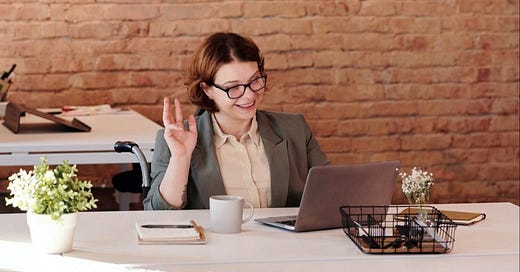Lessons from COVID-19: Creating a more accessible, inclusive post-pandemic reality
With the COVID-19 vaccine in distribution mode, society sees a return to normal in the near future. But I don’t want the normal from before the pandemic. That normal was not inclusive, accessible or ideal for me and others with disabilities. It wasn’t equal; it had injustice written all over it. I want to create a new normal, using what we’ve learned since last spring.
During my first few semesters at Syracuse University, I often found myself between a rock and a hard place. The Newhouse School would often invite alumni to speak and interact with students, but the events would often be at night or on Fridays, when I wasn’t on campus. I went to some, but when I did, I needed a ride from a family member. It wasn’t anybody’s fault; it was just reality.
I thought it was a problem I’d never really overcome, but as COVID-19 hit, the solution fell into my lap. Those speakers became virtual events, where, instead of needing a ride to campus, all I needed was an email with a Zoom link. My computer went from a place to do coursework to my gateway into a new reality — a reality I can only hope is permanent, not temporary.
Technology has been instrumental in enabling people with disabilities, but I believe videoconferencing technologies could to be a substantial turning point in the movement toward inclusion. These can open numerous doors for those with disabilities in a post-pandemic world; society just has to keep them unlocked.
When I was growing up, people would tell me that I’d be entering the workforce at a time when remote work was common. They obviously didn’t know there would be a global pandemic that would change society as I graduated college, but I have realized what they were saying.
Rushing out of the house each morning, getting a ride to work, accomplishing tasks while at work, and then going back home would be difficult. It’s not that it would be impossible, but it would be challenging. And this is the case for others with disabilities. We often focus about what’s most ideal or productive rather than what’s possible, simply because time is of the essence.
I want to spend my time making a difference, not juggling an unideal situation. Even with somebody’s help, it’s difficult to travel wherever I need to go or to navigate older buildings. Often, I have to ask someone where ramps and elevators are, which takes time and planning. Altogether, when physically going somewhere, I — and whoever iccompanies me — need to leave anywhere from 10 to 30 minutes to spare, just in case something goes wrong, like having to search for hidden ramps and elevators.
None of that has to be a factor with virtual environments. I’m not saying I don’t want to physically get out into the world once the pandemic ends, but I want to maintain this additional freedom. We have — intentionally or not — made strides toward further inclusion, and though it’s not perfect, it’s a work in progress. But moving backward after the pandemic would be a massive societal failure and disappointment.
The way I see it, this could be a turning point for the disability community. Because of transportation and other logistical issues, it’s difficult for me, and others with disabilities, to do what we want. Over the past decade or so, we’ve had the opportunity to interact with one another or raise awareness on social media. But those two things won’t directly enact the change we are looking for.
We haven’t been empowered, and I don’t see how social media has done anything other than helped to raise awareness. At this point, though, we need more than mere awareness.
I can hear the excuses for not including people with disabilities ring in my ear: that we don’t have the ability to speak for ourselves and that our loved ones would advocate for us if needed. They disgust me. They’re poisonous, oppressive lies, and they always have been. We can speak up, and I feel like we have an opportunity to turn things around in this pivotal moment.
In my story about the lack of inclusion of people — specifically students — with disabilities on college campuses from last month, I said “we remain stuck because we lack the numbers to demand change through mass protests.” I briefly explained how we lack a coalition to create change. However, I think we can create one if we refuse to return to the ableist normalcy that leaves us out. We just can’t settle.
We must demand meetings — public and private, but public, specifically — continue to be available virtually, even after the pandemic ends. I am demanding that right now, as that’s the only way they’ll be truly inclusive and accessible to all. It’s not good enough for records or notes to be available after. Meetings have to be available live online so people with disabilities have equal access and the ability to chime in. Not making sure they can is discrimination — it excludes people from the meeting on the basis of disability.
Most importantly, if we are going to resist a return to ableist norms, we have to communicate with one another. Historically, we have been few and far between, making a true disability rights movement extremely difficult. But we need to realize that uniting as a community is now a virtual meeting away. It doesn’t matter where we are physically; it matters that we’re on the same page in intensifying our movement — united in the creation of a new normal, because when we create a coalition, we can create change.
Originally published at http://www.wheelchairqb.com on January 17, 2021.



